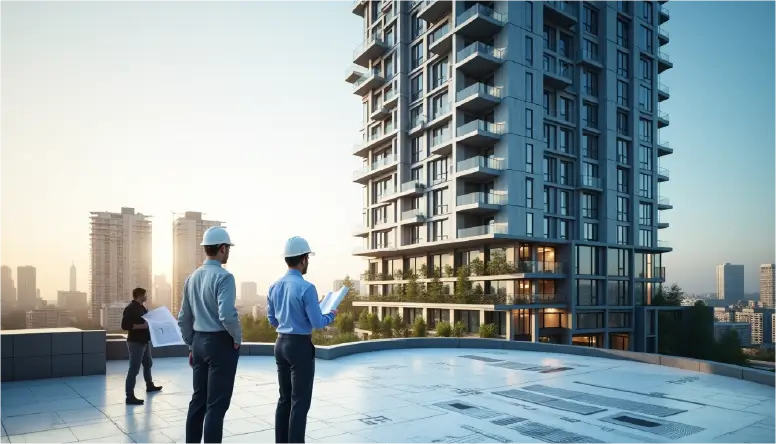A structural integrity reserve study guides you to keep buildings safe and financially stable. These detailed assessments help property managers and board members understand their building’s current state and what maintenance lies ahead. These tools are significant to plan and budget repairs and replacements.
Building parts like windows and foundations need regular checks to avoid getting pricey failures. Your association will make better decisions about properties when you understand what these studies offer. On top of that, it helps you follow state rules and protect property values when you put the study’s recommendations into action.
What is a Structural Integrity Reserve Study?
Definition and purpose
A Structural Integrity Reserve Study (SIRS) is a detailed evaluation that combines structural engineering assessment with financial planning for building maintenance. This forward-thinking assessment gets into the building’s foundation and framework to ensure long-term stability 1.
SIRS helps identify existing or potential structural problems that could lead to major maintenance costs in the future. The assessment provides a strategic outlook for 20 to 30 years and ensures associations have enough financial resources to handle maintenance and repairs 3.
Key components of a SIRS
The study includes ten structural elements that need a full picture:
- Roof systems
- Primary structural systems
- Load-bearing walls
- Fireproofing and fire safety
- Exterior painting and waterproofing
- Plumbing systems
- Electrical systems
- Exterior doors
- Windows
- Components exceeding $10,000 affecting structural integrity 1
Licensed engineers or architects must do visual inspections during the assessment 2. On top of that, the study has detailed financial forecasts to plan funds for the most important repairs or replacements 1.
Legal requirements in Florida
Florida’s law sets specific requirements for conducting SIRS. Associations that existed before July 1, 2022, must complete their original study by December 31, 2024. The law requires these studies every ten years 1.
Buildings that fall under SIRS requirements include:
- Structures three stories or higher
- Buildings within three miles of coastline aged 25 years or older
- All qualifying buildings must maintain separate SIRS reserve budgets 2
The Florida Department of Business and Professional Regulation oversees compliance for inspection reports, studies, and reserve funding 2. Officers and directors who fail to get a SIRS breach their fiduciary responsibilities to owners 2.
The SIRS Process: From Inspection to Implementation
Licensed engineers and architects perform structural integrity reserve studies through a systematic process that will give a full picture of the building’s condition. They complete their work by doing this with specific protocols to protect building safety and financial stability.
Property Assessment and Milestone Inspections
Professional engineers start with a detailed visual inspection of the building’s structural components. The inspection process has two distinct phases. Engineers get into all building areas to find substantial structural deterioration in Phase 1. The team moves to Phase 2 when they find deterioration, which requires extensive testing and detailed evaluation 5.
The inspection has these essential components:
- Load-bearing walls and primary structural members
- Fireproofing systems
- Plumbing infrastructure
- Electrical systems
- Waterproofing elements 6
Financial Analysis and Reserve Fund Planning
Financial experts analyze the association’s current reserve funds and projected maintenance costs after completing the physical assessment 3. The analysis has a more detailed funding strategy that covers 30 years 6. They review operating budgets, interest rates on reserve accounts, and pertinent declarations as part of this process.
Specialists determine each component’s remaining useful life and gather replacement cost estimates. These findings are the foundations of a recommended funding plan that will give adequate reserves for future repairs.
Executing Recommendations and Ongoing Monitoring
Organizations start by ranking projects based on their urgency and resource availability. They must also set up regular inspection processes to catch problems early. The monitoring system has regular checks of common elements and keeps track of any structural condition changes.
Engineers carefully watch how building components wear down through constant evaluation. They make updates to maintenance schedules and adjust funding plans whenever needed 3. This continuous process helps the structural integrity reserve study stay accurate and work well over time.
Benefits and Challenges of Conducting SIRS
A structural integrity reserve study offers the most important advantages despite certain challenges that associations and unit owners face. Organizations can prepare better and maximize their assessment’s benefits when they understand everything involved in the process.
Advantages for associations and unit owners
SIRS implementation offers many benefits for property management and maintenance. These studies help maintain and improve property values by a lot 9.
Key advantages include:
- Spotting risks early makes properties safer
- Properties keep their value better
- Financial planning becomes more precise
- Relationships with insurers and lenders improve
Properties with proper SIRS documentation build better relationships with insurance providers. Those showing good financial preparation might get better insurance rates.
Common obstacles and how to overcome them
Associations often face several challenges when carrying out structural integrity reserve studies. At first, building structures can be too complex and need more detailed assessments. The budget limits also create big hurdles for many organizations.
Managing unexpected costs and adapting to new financial needs remain the biggest problems. Boards now use different strategies to tackle these challenges effectively. Organizations are learning about several funding options that include:
- Special assessments to handle urgent repairs
- Lines of credit to spread out costs
- Detailed maintenance planning
Long-term financial planning and risk mitigation
SIRS helps associations maintain their structural integrity and manage costs through sound long-term financial planning. Organizations can project their revenues and expenses across extended periods 13. This planning process helps decision-makers concentrate on strategic goals and boost financial literacy.
Lenders and insurers now inspect reserve studies with greater attention, making risk mitigation crucial. Properties that have well-documented maintenance plans and healthy reserve funds tend to sell at higher market values.
Insurance companies have started using reserve study data in their risk models. Associations that maintain adequate reserves can benefit from:
- Lower insurance premiums
- Better coverage options
- Reduced risk of coverage restrictions
Sound financial planning prevents unexpected financial strain on unit owners 12. Boards now create detailed maintenance plans that tackle both current needs and future repairs.
Conclusion
Final Insights on Structural Integrity Studies
Property associations use structural integrity reserve studies as essential tools to keep buildings safe and finances stable. These detailed assessments blend technical expertise with financial planning and help boards make smart decisions about repairs. Professional evaluations of critical building parts, combined with financial forecasts, build a strong foundation for managing properties effectively.
Property associations that adopt regular structural integrity studies set themselves up for lasting success. They do this through active maintenance and careful risk management. These regular checks protect property values and ensure compliance with state rules and insurance needs. Smart associations know these studies are vital investments in their properties’ future. This approach leads to well-maintained buildings and financially healthy communities.
Related Articles:
- Meeting SIRS Requirements: Best Practices for Structural Integrity
“Best practices for meeting SIRS requirements to ensure structural integrity in community associations.” - Milestone Inspection Breakdown: What You Need to Prepare
“Preparation tips for milestone inspections to maintain structural integrity.” - Reserve Study Basics: Essential Planning for HOA Boards
“Essential planning tips for HOA boards conducting reserve studies.”








